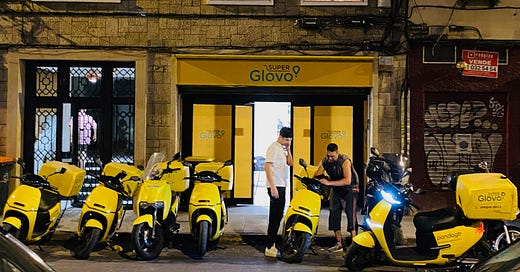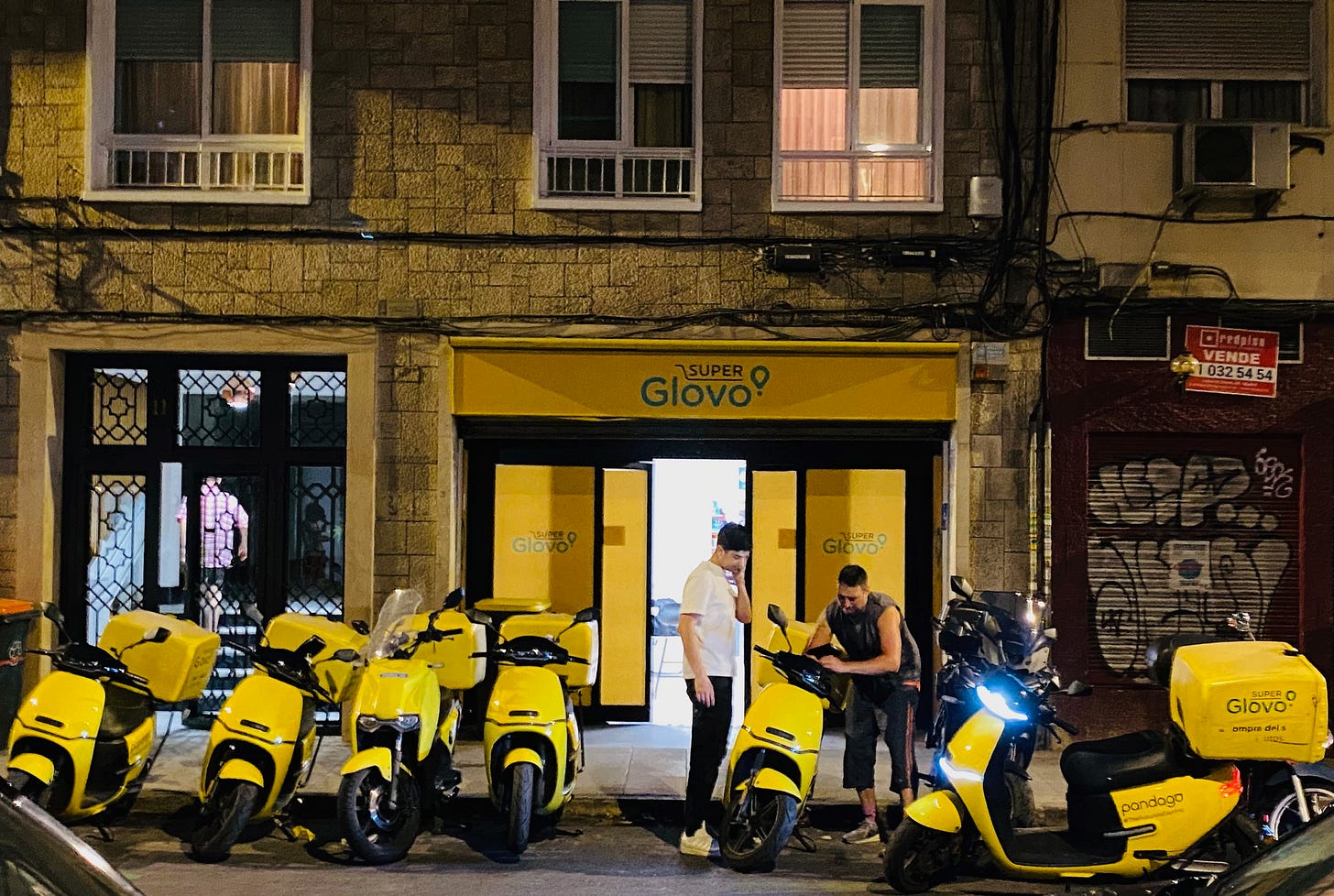Can food delivery platforms “eat” restaurant density?
Cities’ need access to data to shape urban life, or they'll let platforms reshape it
Urbanists tend to fixate on boosting density, particularly by facilitating the building of more homes. Housing density is crucial, but it’s not the only density that matters.
Recently, Noah Smith wrote about the importance of commercial density The same is true for restaurants. Having more and diverse places to eat is key for city vibrancy, but this core component of the urban fabric is going through a deep transformation - one served by riders speeding through narrow streets to deliver their next order, following the instructions of an algorithm.
Food delivery platforms are changing cities’ consumption patterns, the restaurant industry, and the use of public space. Some of these shifts are great - we all enjoy the convenience - but cities need a deeper understanding of all their implications. And for that, they need better data.
Dining out: the social infrastructure of cities
Restaurants serve more than one basic human need. We all need to eat, but we also need to socialize and meet other people. Going out for lunch or dinner is both a way to spend money for pure joy, to create the right ambiance for a date or an opportunity to make business, and a livelihood for restaurateurs, cooks, waiters… as well as tech-entrepreneurs and riders!
By performing all these functions, restaurants have become a central engine of cities’ economic life. While getting accurate data is hard, cities like Madrid or New York seem to dedicate around 15 to 20% of their store-front floor space to restaurants that generate hundreds of thousands of jobs.
Restaurants also produce other benefits. Owners want clean and safe streets and sidewalks, often acting as the stewards of public space. Restaurants also generate Jane Jacobs’ “city rhythms”. They attract workers who get their early coffee before starting their work day. Other customers stop by on their way to an errand; some will gather at lunch-time to reconnect during their breaks. Towards the end of the day, younger professionals, couples, or groups of friends will come to relax and have fun. At different times of the day, restaurants and cafés, together with shops, create the flows that produce city life. The more diverse and fragmented this offering is, the more varied flows - and life - it will create.
You can see this in Madrid. In any neighborhood within the inner ring you can still walk through streets where a small butcher shares the sidewalk with a barber and a spare-parts shop. Often, these shops sit next to a small cafeteria run by an old couple who knows their patrons by name. Many of the clients live in their neighborhood, others are just visiting the different shops nearby.
I have no doubt that this local taste, this colorful authenticity, is one of the reasons that has made Madrid such an attractive city. And yet, in Madrid, like in many other cities, these same streets are now filled with riders entering some of these restaurants, parking their bikes in the sidewalks while they pick up their orders, before speeding on to the next delivery. This is not bad per se, but is worth reflecting on how this new consumption pattern may affect urban life.
Knock, knock, knockin’ on clients’ door
Food delivery is not a new thing, but was often limited to a few types of restaurants like pizza chains. This started to change in the 2000s, with pioneering websites that morphed into the modern multi‑restaurant apps that took off in the early 2010s. Then came the pandemic.
Covid-19 turbocharged restaurant delivery platforms. With everyone locked at home, platforms enabled restaurants to continue serving clients. Some people thought that, after the pandemic, platforms’ businesses would wind down, but the opposite has become true. Changes in consumption patterns stuck, even after pandemic-related restrictions were lifted. Recent research by the National Restaurant Association in the US reports:
“In 2019, off-premises traffic represented 19% of all traffic at full service operations and 76% at limited-services restaurants. In 2024, those percentages jumped to 30% and 83%, respectively.”
This is also shown in food delivery platforms' continuous growth in recent years, with some analysts reporting a solid average of 10% growth across main restaurant delivery platforms in the last quarter of 2024.
What does this mean for restaurants? To start, those places whose main value proposition revolves around “physical presence” may see fewer people coming to dine-in. At the same time, food delivery can add, rather than subtract, customers to all restaurants. In other words, in addition to serving patrons that go eat in the place, restaurants can now serve a larger number of customers. Delivery platforms provide an additional source of revenue for all restaurants. At the end of the day, dine-in is limited by physical space, so having additional capacity to reach other customers and use existing assets should be welcome.
But food delivery platforms also create other dynamics. They increase fierce competition among restaurants. They also add fees that eat already slim margins. Reportedly, these fees can be more burdensome to independent restaurants than to big chains. So, if independent and small restaurants become too dependent on platforms, these fees can, ultimately, drive them out of business.
This is what a recent study by Raj & Eggers at Wharton and NYU finds:
Platforms also affect restaurants’ locations in the city map. Traditionally, opening in prime places was a key strategic choice, and a competitive advantage, for restaurants. Where an owner located their restaurant highly affected the success of their business. With delivery platforms, other restaurants farther away can outcompete these well-placed restaurants, especially if their prime location is not that important for their customer base, and yet keeps the rent as expensive as always.
Add to this the emergence of dark kitchens: locales for food production that do not serve directly to clients, but cater exclusively online deliveries. These kitchens not only compete with restaurants for online customers, but they can also grab physical space. While many of them may not be located in prime locations, some of them are placed in areas that could have otherwise served as restaurants.
Five years ago, the owner of a newly-opened tiny Korean restaurant at a centric market in Madrid complained about this competition with dark kitchens. While preparing my delicious meal, and after describing his life in Korea and his vision to bring Seoul’s street food to Madrid, he confessed that he was struggling with the rent. The managers wanted to transform the market into a hub for dark kitchens, so they were trying to push small restaurants like his out. I cannot confirm this, though. To this day, the restaurant is there, and seems to be doing great. The food still is delicious. That I can confirm.
Shedding light on dark kitchens
It’s hard to predict how the emergence of delivery platforms will affect cities. Some studies, and other stories, predict gloomy prospects for restaurants, and as a result, for the vibrancy of cities. Many restaurants will struggle with the new competitive dynamics. Others will thrive by the new revenue sources opened by these distribution channels. Certain restaurants will not be able to locate in some neighborhoods, but others will continue to offer a nice dine-in experience, and thrive in doing so.
Delivery platforms are here to stay, and their impacts will vary across cities and across restaurant types. One thing is clear, though: most city governments have very little information on the impacts that delivery platforms are having in their streets.
They shouldn’t be making decisions in the dark. Data exists. Platforms are collecting tons of data to run their operations. Such information can be very valuable, not just to understand whether restaurant density is changing, and how, but also to measure other impacts resulting from food delivery platforms, such as the use of public space or road and street safety.
A city official reading this post could react by approaching platforms with a “give me all the data you’ve got” ask. This is counter-productive, as well as useless. Instead, cities can engage platforms to get the “minimum-vital-information” and follow a simple playbook to better inform their decisions:
Define the policy question. (e.g., “Is the restaurant mix in certain neighborhoods skewing toward chains?”)
Request “minimum-vital-info”: counts of online orders per postal code, delivery origin/destination at district level, rider parking footprint, and dwell time.
Work with an intermediary to ensure that proprietary data is safe and secure, and to transform it into meaningful insights.
Use insights to generate policy discussions and inform permitting, fees, and other policies.
Lighting the policy path with data and partnerships
Platforms come with benefits and downsides. If they weren’t so convenient, we wouldn’t be constantly using them. They also produce data that did not exist before. Insights gleaned from such data can inform how cities govern restaurant density and the public space. Rather than praising or complaining blindly, city governments should seize this opportunity.
City officials who leverage data will be able to shape platforms. Those who do not will see their cities reshaped by them.





